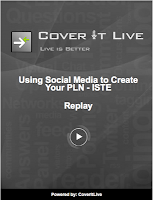 What a WONDERFUL title: Horton Hears a Tweet!!! This is the title of an EduCause article by Joanna Dunlap and Patrick Lowenthal is a comprehensive and insightful article about how Twitter can fulfill the "Challenge of Student Engagement". What I really like about this article is that they compare the process of using Twitter for communication with the process of using an LMS. They talk about how clunky using the LMS for communication can be. It follows the process of:
What a WONDERFUL title: Horton Hears a Tweet!!! This is the title of an EduCause article by Joanna Dunlap and Patrick Lowenthal is a comprehensive and insightful article about how Twitter can fulfill the "Challenge of Student Engagement". What I really like about this article is that they compare the process of using Twitter for communication with the process of using an LMS. They talk about how clunky using the LMS for communication can be. It follows the process of:
Log In>Access Shell>Locate Forum>Post Message>Wait for Response
When compared to Twitter's "natural free-flowing, just-in-time" connection, this is a system for documenting communication rather than fostering it.
Dunlap and Lowenthal discuss the interactivity of using Twitter with both students and professionals. They talk about the positive results and benefits for using Twitter for back-channeling and on-going relevant discussions. They even share events where students answered their own questions using Twitter as an entre to their PLN. They posted questions about projects and received responses in 10 minutes. The only thing that is missing is a discussion of the negatives of using Twitter - - - - I must admit that I can't think of any either, but I thought that they might have some ideas. =-)
This article is MUST-READ material for educators and students alike. They even include a robust list of Additional Readings and Resources.
What do you think? Have you found Twitter to be as advantageous as they say?
Z
Related articles







